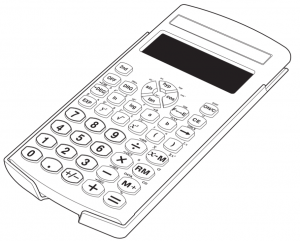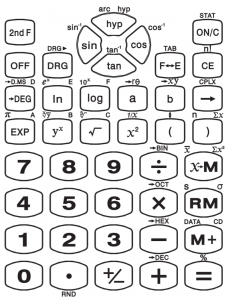TRU RED Scientific Calculator Statistical Function Owner’s Manual TR28201
TR28201
SAFETY PRECAUTIONS
Be sure to read the follow ng safety precautons before using this calculator. Keep this manual handy for later reference
BATTERIES
- After removing the batteries from the calculator, put them in a safe place where there is no danger of them getting into the hands of small children and accidently swallowed.
- Keep batteries out of the reach of children.If accidentally swallowed, consult with a physician immediately.
- Never charge batteries, try to take batteries apart, or allow batteries to become shorted. Never expose batteries to direct heat or dispose of them by incineration.
- Misuse of batteries can cause them to leak acid that can cause damage to nearby items and creates the possibility of fire and personal injury.
- Always make sure that a battery’s positive (+) and negative (-) sides are facing correctly when you load it into the calculator.
- Remove the batteries if you do not plan to use the calculator for a long time.
- Use only the type of batteries specified for this calculator in th s manual.
- Do not mix old and new batteries.
- Do not mix alkaline, standard (Carbon-Zinc), or rechargeable (Nickel Cadmium) batteries.
DISPOSING OF THE CALCULATOR
- Never dispose of the calculator by burning it. Doing so can cause certain components to suddenly burst, creating the danger of fire and personal injury.
- The displays and illustrations (such as key markings) shown in this Owner’s Manual are for illustrative purposes only, and may differ somewhat from the actual items they represent.
- The contents of this manual are subject to change without notice.
HANDLING PRECAUTIONS
- Be sure to press the “ON/C” key before using the calculator for the first time.
- Even if the calculator is operating normally, replace the battery at least once every three years.Dead battery can leak, causing damage to and malfunction of the calculator. Never leave the dead battery in the calculator.
- The battery that comes with this unit discharges slightly during shipment and storage. Because of this, it may require replacement sooner than the normal expected battery life.
- Low battery power can cause memory contents to become corrupted or lost completely. Always keep written records of all important data.
- Avoid use and storage in areas subjected to temperature extremes. Very low temperatures can cause slow display response, total failure of the display, and shortening of battery life. Also avoid leaving the calculator in direct sunlight, near a window, near a heater or anywhere else it might become exposed to very high temperatures. Heat can cause discoloration or deformation of the calculator’s case, and damage to internal circuitry.
- Avoid use and storage in areas subjected to large amounts of humidity and dust. Take care never to leave the calculator where it might be splashed by water or exposed to large amounts of humidity or dust. Such elements can damage internal circuitry.
- Never drop the calculator or otherwise subject it to strong impact.
- Never twist or bend the calculator. Avoid carrying the calculator in the pocket of your trousers or other tight-fitting clothing where it might be subjected to twisting or bending.
- Never try to take the cakulator apart.
- Never press the keys of the calculator with a ball-point pen or other pointed object.
- Use a soft, dry cloth to clean the exterior of the unit.If the calculator becomes very dirty, wipe it off with a cloth moistened in a weak solution of water and a mild neutral household detergent. Wring out all excess moisture before wiping the calculator. Never use thinner, benzine or other volatile agents to clean the calculator. Doing so can remove printed markings and damage the case.
LCD DISPLAY

KEYS LAYOUT

BEFORE STARTING CALCULATIONSOPERATION MODES
When using this calculator, it is necessary to select the proper mode to meet your requirements.
CALCULATION MODES
“DEC” mode [2ndF][ … ]: – general calculations, including function calculations can be executed. Either“DEG”, “RAD” or “GRAD” symbol appears in the LCD display (depends on which angular measurement mode is active).“BIN” mode [2nd F][➔ BIN]:- binary conversion and calculations. “BIN” symbol appears in the LCD display.“OCT” mode [2nd F][➔ OCT]:- octal conversion and calculations. “OCT” symbol appears in the LCD display.“HEX” mode [2ndF)[➔ HEX]:- hexadecimal conversion and calculations. “HEX” symbol appears in the LCD display.“CPLX” mode [2ndF][CPLX):- calculations including complex numbers can be executed. “CPLX” symbol appears in the LCD display.“SD” mode [2nd F][ST AT]:- standard deviation calculation can be executed, “ST AT” symbol appears in the LCD display.
ANGULAR MEASUREMENT MODES
“DEG” mode:- specify measurement in “degrees”.“DEG” symbol appears in display window.“RAD” mode:- specify measurement in “radians”.“RAD” symbol appears in display window.“GRA” mode:- specify measurement in “grads”.“GRAD” symbol appears in display window.These three angular measurement modes can be used in combination with the “DEC” mode.
DISPLAY MODE
“TAB” mode [2ndF] [TAB]:- specify number of decimal places.Moreover you can change the display In exponential format by pressing [F H E].
| Mode | Operation | |
| Decimal | [2ndF]f—+DEC] | DlG,RADorGRAD |
| Binary | t2ndFJt—+BINJ | BIN |
| occal | t2narjt—+oczj | OCT |
| Hexadecimal | [2ndF]f—+HEX] | HEX |
| statistical | t2ndFjtSzAzj | STAT |
| Dep | Press [DRGJ to cycle through “DEG”, “RAD” and ”GRAD”. | DEG |
| Rad | RAD | |
| Grad | GRAD | |
| Tab | [2ndf][TABJ then [0]~[9 | |
| To reset decimal setting | f2ndF]tTAB][•] |
[xyz-ips snippet=”download-snippet”]

